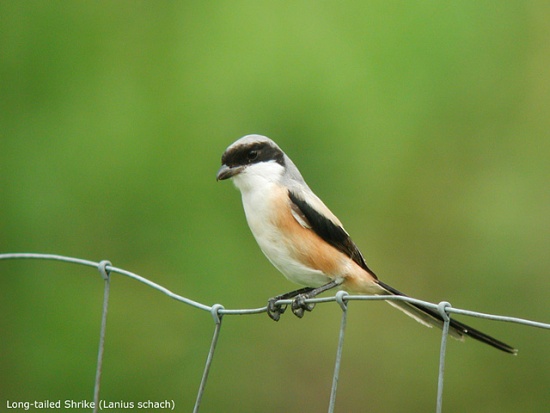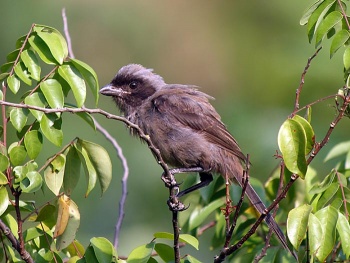(→External Links: New Video search created) |
|||
| (22 intermediate revisions by 6 users not shown) | |||
| Line 1: | Line 1: | ||
| − | + | '''Alternative name: Rufous-backed Shrike''' | |
| − | [[Image:Long-tailed_Shrike.jpg|thumb|550px|right|Photo by Laurence Poh]] | + | [[Image:Long-tailed_Shrike.jpg|thumb|550px|right|Photo © by the late '''[http://www.birdforum.net/gallery/showgallery.php/ppuser/951/cat/500 Laurence Poh]'''<br />Kanthan, Perak, [[Malaysia]], 2000]] |
| + | |||
| + | ;[[:Category:Lanius|Lanius]] schach | ||
==Identification== | ==Identification== | ||
| − | + | *Grey head and mantle | |
| − | + | *Black mask | |
| − | + | *White underparts | |
| + | *Rufous flanks | ||
| + | *Bill and legs are blackish | ||
==Distribution== | ==Distribution== | ||
| − | + | From north-eastern [[Iran]] over [[Pakistan]], [[India]], the [[Himalayas]], [[Sri Lanka]], [[Burma]] and [[Indochina]] to [[Malaysia]], [[Indonesia]] and [[Papua New Guinea]]. Also in south and east [[China]], [[Taiwan]] and the [[Philippines]]. | |
| − | + | [[Image:long-tailed_shrike_alok.JPG|thumb|350px|right|Subspecies ''L. s. erythronotus''<br />Photo © by {{user|aloktewari|Alok Tewari}}<br />Gurgaon Rural, [[India]], February-2017]] | |
==Taxonomy== | ==Taxonomy== | ||
| + | ====Subspecies==== | ||
| + | [[Image:long-tailed_shrike_alok_3.JPG|thumb|350px|right|Juvenile, subspecies ''L. s. erythronotus''<br />Photo © by {{user|aloktewari|Alok Tewari}}<br />[[Keoladeo National Park]], Bharatpur, [[India]], December-2018]] | ||
| + | There are 9 subspecies<sup>[[#References|[1]]]</sup>: | ||
| + | *''L. s. erythronotus'': | ||
| + | :*North-eastern [[Iran]] to [[Pakistan]] and northern [[India]] | ||
| + | *''L. s. caniceps'': Western and southern [[India]] and [[Sri Lanka]] | ||
| + | *''L. s. schach'': Eastern and southern [[China]], [[Taiwan]] and Hainan | ||
| + | *''L. s. tricolor'': [[Nepal]] to northern [[Myanmar]], Yunnan, northern [[Laos]] and northern [[Thailand]] | ||
| + | *''L. s. bentet'': | ||
| + | :*[[Malay Peninsula]], [[Sumatra]], [[Java]], [[Borneo]] and [[Lesser Sundas]] | ||
| + | *''L. s. longicaudatus'': | ||
| + | :*Central and south-eastern [[Thailand]] | ||
| + | *''L. s. nasutus'': | ||
| + | :*[[Philippines|Philippine Islands]] | ||
| + | *''L. s. suluensis'': | ||
| + | :*Sulu Archipelago | ||
| + | *''L. s. stresemanni'': | ||
| + | :*Eastern [[New Guinea]] | ||
==Habitat== | ==Habitat== | ||
| + | Scrubby bushland | ||
==Behaviour== | ==Behaviour== | ||
| − | + | ====Diet==== | |
| + | Diet includes lizards, large insects, small birds and rodents. | ||
| + | [[Image:1568dusky shrike P9187902.jpg|thumb|350px|right|Dark Morph (Dusky Shrike) <br />Photo © by {{user|Neil|Neil}}<br />[[Hong Kong]], [[China]], September 2006 ]] | ||
| + | ==References== | ||
| + | #{{Ref-Clements6thAug16}}#Wikipedia | ||
| + | {{ref}} | ||
| + | ==External Links== | ||
| + | {{GSearch|"Lanius schach" {{!}} "Long-tailed Shrike" {{!}} "Rufous-backed Shrike"}} | ||
| + | <br /> | ||
| + | {{VSearch|"Lanius schach" {{!}} "Long-tailed Shrike" {{!}} "Rufous-backed Shrike", video}} | ||
| + | {{GS-checked}}1 | ||
| + | <br /> | ||
| + | <br /> | ||
| − | + | [[Category:Birds]] [[Category:Lanius]] [[Category:Videos]] | |
| − | |||
| − | |||
| − | |||
| − | |||
| − | |||
| − | [[Category: | ||
Latest revision as of 00:09, 13 February 2023
Alternative name: Rufous-backed Shrike
- Lanius schach
Identification
- Grey head and mantle
- Black mask
- White underparts
- Rufous flanks
- Bill and legs are blackish
Distribution
From north-eastern Iran over Pakistan, India, the Himalayas, Sri Lanka, Burma and Indochina to Malaysia, Indonesia and Papua New Guinea. Also in south and east China, Taiwan and the Philippines.
Taxonomy
Subspecies

Juvenile, subspecies L. s. erythronotus
Photo © by Alok Tewari
Keoladeo National Park, Bharatpur, India, December-2018
Photo © by Alok Tewari
Keoladeo National Park, Bharatpur, India, December-2018
There are 9 subspecies[1]:
- L. s. erythronotus:
- L. s. caniceps: Western and southern India and Sri Lanka
- L. s. schach: Eastern and southern China, Taiwan and Hainan
- L. s. tricolor: Nepal to northern Myanmar, Yunnan, northern Laos and northern Thailand
- L. s. bentet:
- L. s. longicaudatus:
- Central and south-eastern Thailand
- L. s. nasutus:
- L. s. suluensis:
- Sulu Archipelago
- L. s. stresemanni:
- Eastern New Guinea
Habitat
Scrubby bushland
Behaviour
Diet
Diet includes lizards, large insects, small birds and rodents.
References
- Clements, J. F., T. S. Schulenberg, M. J. Iliff, D. Roberson, T. A. Fredericks, B. L. Sullivan, and C. L. Wood. 2016. The eBird/Clements checklist of birds of the world: v2016, with updates to August 2016. Downloaded from http://www.birds.cornell.edu/clementschecklist/download/
- Wikipedia
Recommended Citation
- BirdForum Opus contributors. (2024) Long-tailed Shrike. In: BirdForum, the forum for wild birds and birding. Retrieved 18 May 2024 from https://www.birdforum.net/opus/Long-tailed_Shrike
External Links
GSearch checked for 2020 platform.1






